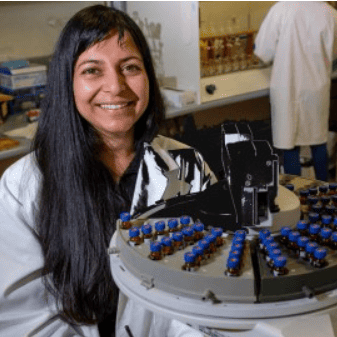Manpreet Dhami
Manaaki Whenua – Landcare Research
Exploring future pathways for protecting our taonga
The inventory of research outputs and resources can be found here:
Technological innovation is racing ahead around the globe, but what does this mean for Aotearoa? Before we adopt any new technology we must ensure it is suitable for our lands, our native species and our people. This four-part research programme delved into different molecular technologies and what they might look like in a New Zealand context.
This social research team partnered with Te Tira Whakamātaki and engaged with people to talk about the role genetic technologies could play in their visions for the future of environmental conservation in Aotearoa New Zealand.
To find out more visit their website by clicking here or follow them on X (Twitter).
Austropuccina psidii was found in Aotearoa in 2017 and has been spreading throughout the country ever since. When the pathogen is blown by the wind onto a myrtle plant it can cause myrtle rust. This disease is already causing localised extinctions of some of our native species and is threatening many others.
The RNAi for myrtle rust team aimed to demonstrate a proof-of-concept that RNAi targeting putative pathogenicity genes of Austropuccinia psidii can prevent myrtle rust development. This goal was inspired by work in Australia, which showed the same process targeting house-keeping genes can reduce or prevent myrtle rust development. By targeting putative pathogenicity genes, our scientists hoped to develop a method that carries less risk of non-target effects.
The Varroa mite (Varroa destructor) was first found in Aotearoa in 2000 and has now spread throughout the country, with the exception of the Chatham Islands. The mites parasitise honey bees – increasing virus transmission, causing parasitic mite syndrome and the eventual death of the colony. Current Varroa control usually involves the use of miticides, which can have non-target effects and lead to resistance within the mite population.
This research team investigated the fesibility of using RNAi to control Varroa mites in honey bee hives in Aotearoa. Finding a species-specific control would reduce or eliminate the need for miticides, reducing risk to the wider environment.
The team also looked at social and cultural perspectives of RNAi technology: running a workshop, funding a Master’s thesis on the topic and developing communication tools to convey the benefits and risks.
Environmental DNA (eDNA) detection can be a useful tool in both the biosecurity and biodiversity spaces, but only if there is a reference DNA library that can help tell you what you’ve found. Previous research has uncovered huge gaps in our ‘library’ in Aotearoa, which prevents us using this technology to it’s fullest extent.
The National DNA reference library team worked towards delivering a White Paper to government that provided an investment case for developing a national DNA reference library. This library would be founded on and governed by Te Tiriti o Waitangi.
This mahi included reviewing how such libraries work overseas, running a wānanga series to discuss how this might translate to Aotearoa, and working with Te Rōpū Rangapūtanga Tiriti (Manaaki Whenua’s Te Tiriti Partnership Group for collections and databases) and SING to work out the logistics of how a library might operate.
For additional information and webinar recordings, please see Te Tiriti-guided national DNA reference library wānanga series, hosted by Manaaki Whenua Landcare Research.

Manpreet Dhami

Holden Hohaia

Marie McEntee

Fabien Medvecky

Ocean Mercier

Phil Lester

Symon Palmer

Grant Smith